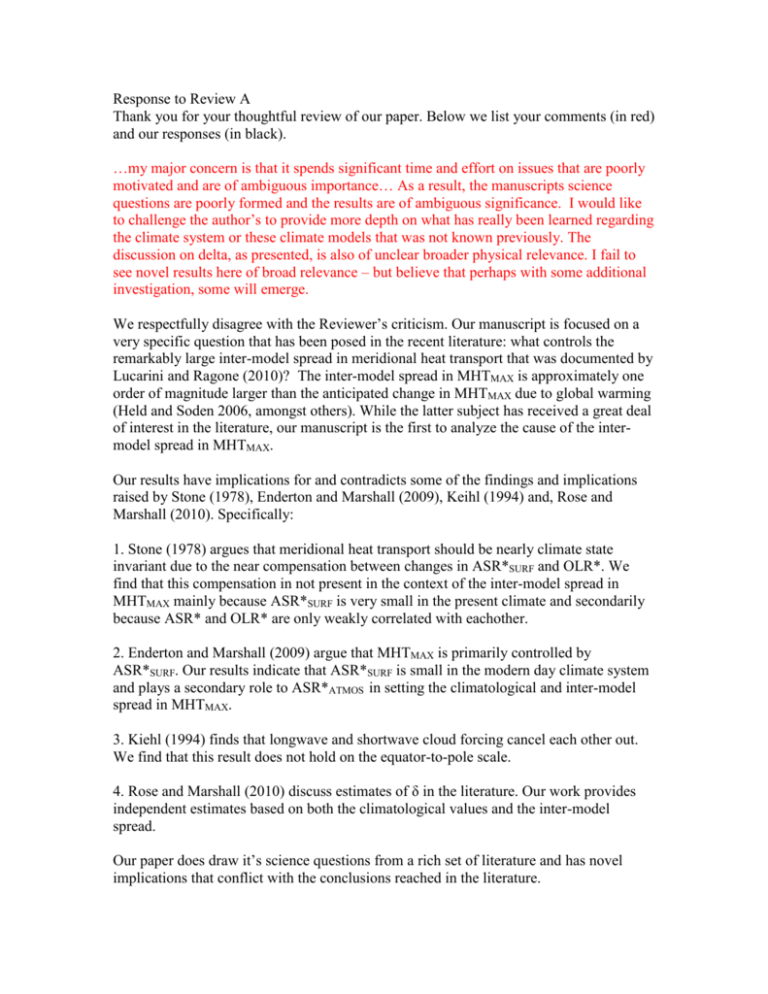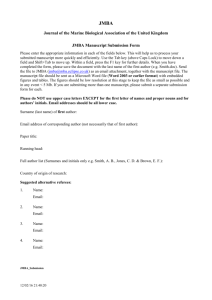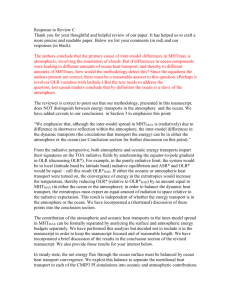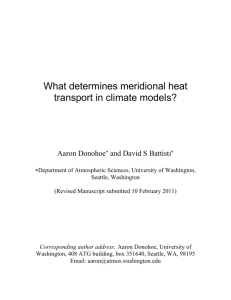A_response - Atmospheric Sciences
advertisement

Response to Review A Thank you for your thoughtful review of our paper. Below we list your comments (in red) and our responses (in black). …my major concern is that it spends significant time and effort on issues that are poorly motivated and are of ambiguous importance… As a result, the manuscripts science questions are poorly formed and the results are of ambiguous significance. I would like to challenge the author’s to provide more depth on what has really been learned regarding the climate system or these climate models that was not known previously. The discussion on delta, as presented, is also of unclear broader physical relevance. I fail to see novel results here of broad relevance – but believe that perhaps with some additional investigation, some will emerge. We respectfully disagree with the Reviewer’s criticism. Our manuscript is focused on a very specific question that has been posed in the recent literature: what controls the remarkably large inter-model spread in meridional heat transport that was documented by Lucarini and Ragone (2010)? The inter-model spread in MHTMAX is approximately one order of magnitude larger than the anticipated change in MHTMAX due to global warming (Held and Soden 2006, amongst others). While the latter subject has received a great deal of interest in the literature, our manuscript is the first to analyze the cause of the intermodel spread in MHTMAX. Our results have implications for and contradicts some of the findings and implications raised by Stone (1978), Enderton and Marshall (2009), Keihl (1994) and, Rose and Marshall (2010). Specifically: 1. Stone (1978) argues that meridional heat transport should be nearly climate state invariant due to the near compensation between changes in ASR*SURF and OLR*. We find that this compensation in not present in the context of the inter-model spread in MHTMAX mainly because ASR*SURF is very small in the present climate and secondarily because ASR* and OLR* are only weakly correlated with eachother. 2. Enderton and Marshall (2009) argue that MHTMAX is primarily controlled by ASR*SURF. Our results indicate that ASR*SURF is small in the modern day climate system and plays a secondary role to ASR*ATMOS in setting the climatological and inter-model spread in MHTMAX. 3. Kiehl (1994) finds that longwave and shortwave cloud forcing cancel each other out. We find that this result does not hold on the equator-to-pole scale. 4. Rose and Marshall (2010) discuss estimates of δ in the literature. Our work provides independent estimates based on both the climatological values and the inter-model spread. Our paper does draw it’s science questions from a rich set of literature and has novel implications that conflict with the conclusions reached in the literature. Moreover, the abstract reads like a paper from the early 1980 with few citations from the rich literature of the past few decades. There is much that has been done on diagnosing the flows of energy in the climate system (in both observations and models) that has not been considered in this manuscript and a wealth of literature from the 1990s and 2000s has been ignored. It was widely recognized that the shortwave effects of clouds are central to these models and their projections, and that major biases exist that project onto meridional transports. Many of the papers newer results have already been published (e.g. Trenberth and Fasullo 2010 JCLIM) and broader physical insights into the models beyond this are generally lacking. Our manuscript cites many papers from the last decade. We regret having not included a citation to Trenberth and Fasullo (2010) in the original manuscript and we have added a discussion of their results and a citation in the revised manuscript. Trenberth and Fasullo (2010) is certainly pertinent to our results but is primarily focused on the difference between the CMIP3 ensemble average and the observations while our manuscript is focused on the cause of the inter-model spread in heat transport. The Reviewer’s suggestion that the primary conclusions of our manuscript have been published in Trenberth and Fasullo (2010) or elsewhere is a gross misrepresentation of the work and insights presented in our manuscript. We agree with the Reviewer’s statement that a wealth of rich literature has been published in the last decades on energy flows in the climate system, both observational and in models. Our manuscript is focused on the more narrowly defined question of what control’s MHTMAX from the perspective of the TOA energy budget. If we have missed additional references that discuss this problem, we apologize and would be happy to include them. We believe that a thorough discussion of the all the literature that discusses energy flow in the climate system would be tangential to the narrow focus of our manuscript and could potentially detract readers from the main points made in our manuscript. Many of the issues raised in the introduction are currently well known (e.g. “Donohoe and Battisti demonstrated that the vast majority of the global average planetary albedo is due to atmospheric as opposed to surface processes” – really? is this novel?) and were answered at the outset of the satellite era… I find it obvious that the surface albedo plays a very minor role in setting the equator-to-pole gradient The formal and quanitative partitioning of the climatological planetary albedo into separate atmospheric and surface components that was performed by Donohoe and Battisti (2011) is, in our opinion, the best citation on this subject primarily because their technique is replicated in our manuscript. If a predecessor citation exists, we apologize and would be happy to revise the citation. While the reviewer may find this point (that the meridional gradient in surface albedo contributes little to the meridional gradient in planetary albedo) obvious, we are unaware (and rather confident) that it has NOT been formally addressed in the literature. If we have missed a citation, we would be happy to reconsider the inclusion of this analysis in our manuscript. Furthermore, it has been suggested elsewhere in the literature (Stone 1978 and Enderton and Marshall 2009) that surface albedo does play a major role in determining MHTMAX and we believe our manuscript is the first to formally counter that belief in the context of the modern day climate system. I like the development of the concepts of ASR* and feel it could be useful but don’t see any evidence that it has yet provided meaningful insights. We respectfully disagree with the Reviewer. We clearly demonstrate that inter-model differences in MHTMAX are primarily due to differences in ASR* and therefore understanding differences in the heat transport hinges critically on understanding model differences in ASR*. This is the primary point of our manuscript and the Reviewer’s denial of ASR*’s utility in this context is both disconcerting and detrimental to his/her ability to access the merits of our manuscript. MINOR POINTS The data is adequate but the models have not been adequately scrutinized. Have you accounted for model biases and errors in the CMIP3 dataset? Are models employing flux corrections considered? Why or why not? Globally invariant radiative flux corrections are applied to each model in order to satisfy the global and annual mean energy budget. These corrections are discussed in the manuscript. The brief nature of the obs should be recognized as a caveat of the results. Perhaps error bars should also be included to account for inter-instrument spread and temporal variability. The models used are for PI conditions and thus differ considerably in their forcing from the observations, which are associated with rather heavily forced conditions both in regards to aerosols and greenhouse gases. These forcings, particularly aerosols, will have a considerably impact on ASR*. But yet they are compared as being equivalent and these influences are ignored. We have added caveats regarding observational errors, the short duration of the observations, and the difference in atmospheric forcing agents between the observations and the PI simulations. These caveats appear where the observations are first described and the observational error is also cited when we make comparisons between the observations and the models. Our impression is that the observational errors on MHTMAX derived are a source of debate in the literature and subject to some unconstrained assumptions (Carl Wunsch, personal communication) and we are uncomfortable giving quantitative estimates of the uncertainty. Differences in MHTMAX are primarily due to differences in ASR (differences in OLR are uncorrelated). ASR differences are separated into those relating to solar insolation and those relating to surface and atmospheric reflection. But what is the broader significance of these findings? Please see our response to your primary major concern. In short, our finding reduces the MHTMAX spread to understanding ASR* only, which we then subsequently subdivide into component contributions. The latitude defining the extratropics should be mentioned in abstract. The definition of the extratropics (the region receiving an annual mean net radiative deficit at the top of the atmosphere) has been added to the abstract in the revised manuscript. type-o: "altered meridional distributions of planetary albedo" Fixed. p25 type-o: "setting -the- equator-to-pole..." Fixed.










